#residential schools
Text
I know I don’t have a large following. I know this post will get lost in the sea of other posts. I know I don’t come on here often, and when I do I try to keep my page free from death and other serious topics. Yet, I think this is imperative to say, especially since I myself am of indigenous descent. I ask all of you to join me in solidarity.
Cole Brings Plenty, actor, model, and most importantly activist was found dead. He was assaulted in a club in Lawrence, Kansas. He was killed and his braids; a symbol of his heritage, of his Lakota decent, and a sacred symbol across many an indigenous nation, were forcibly cut.
I beg of thee and I plead with thee, spread the word. Do your part, however big or little, to bring light to this situation. Whether it be by reblogging this post or others alike, or by going out and making a stand. Do it.
Shed light on the situation. This goes beyond the death of one man. It is about the abuse and the destruction of natives and their communities. Of the killing of many an innocent soul. Of the brutalization of many First Nations.
We have seen time and time again, many indigenous people die by similar means. We need to bring light on the deaths of any and all indigenous individuals dead, missing or at risk. It is an epidemic, an assault, and a silent cleansing of many a nation.
Whether it be the estimated 6,000 dead at the hands of Canadian residential schools, the murdered and missing indigenous women and children, or the killing of an actor and activist, you cannot deny the sheer abhorrence of this problem. The problem of many Native American people dying, going missing and being abused, at an alarming rate. At a level unprecedented and unparalleled, at a level of which should not be kept silent.
Cole Brings Plenty, actor, model, activist.
Look at him and spread awareness for him and for many others befallen by the same fate.

Remember him. Remember all of the others. Let nobody else befall the same fate again.
#cole brings plenty#first nations#indigenous#indigenous americans#native american#Canadian residential schools#residential schools#tw death#mmiw#mmiwg2s#please join me in solidarity and spread this word as much as possible#i beg of you#colored text#long post
899 notes
·
View notes
Text

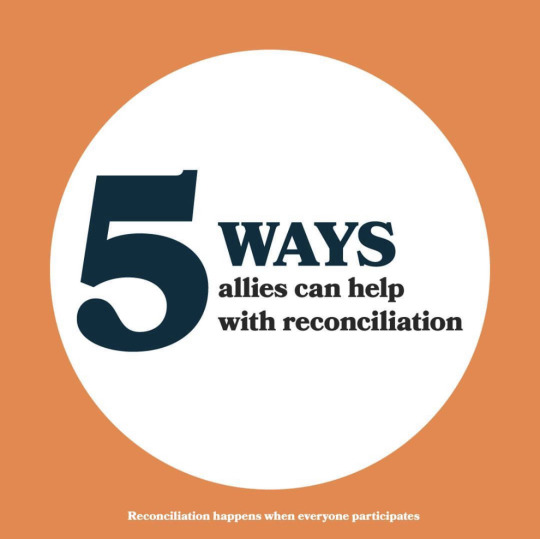
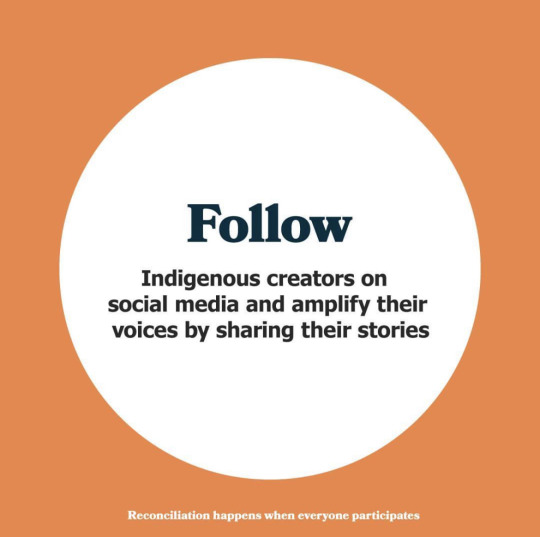
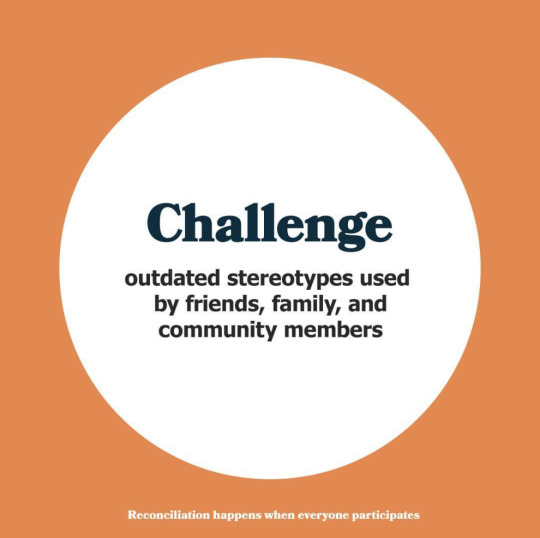

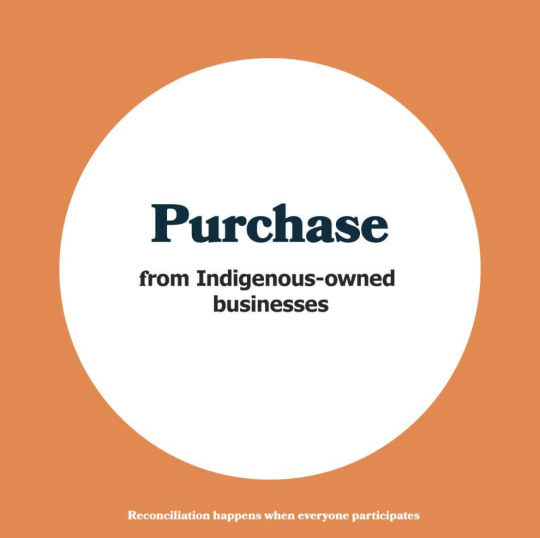

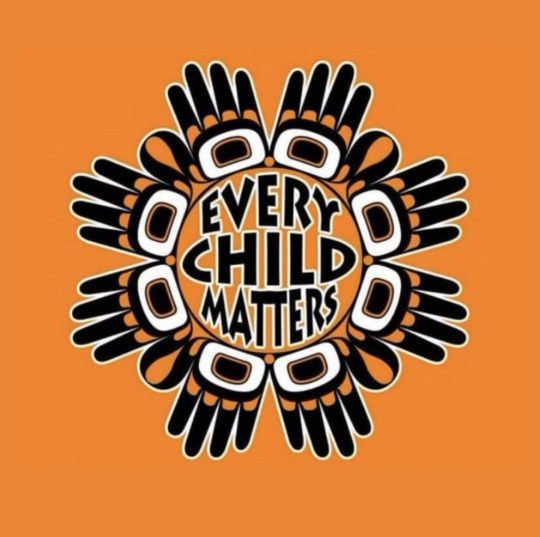
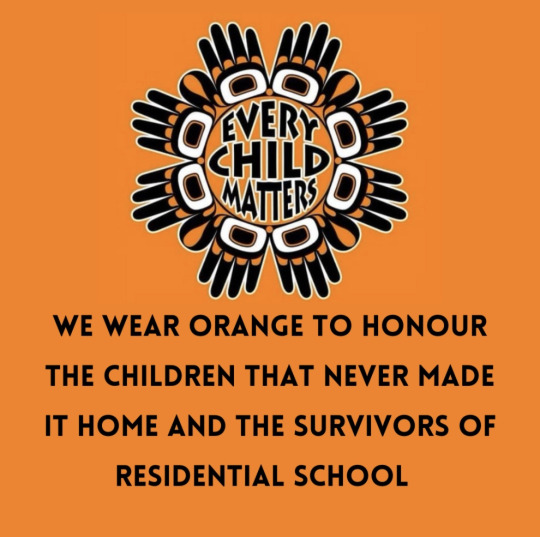
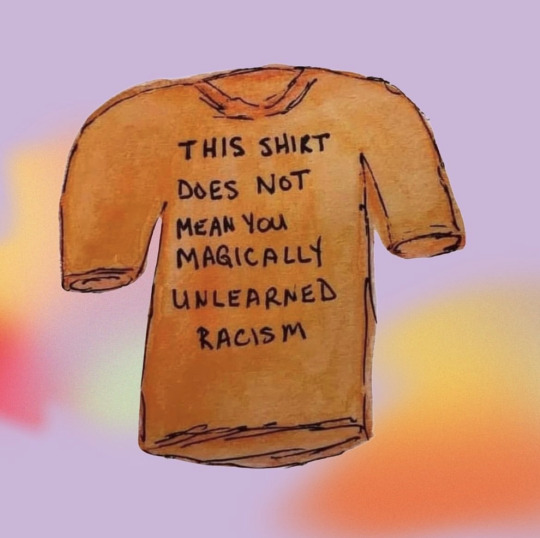
Orange shirt day tomorrow. Once again, I’m of mixed feelings. Happy that we have a day that let’s non-Indigenous people know.., but sad we even have to make a day to be noticed or cared about.
Trying to spread awareness and love.
🧡🧡🧡🧡🧡🧡🧡🧡🧡🧡🧡🧡🧡🧡🧡🧡🧡🧡🧡🧡🧡🧡🧡🧡🧡🧡🧡🧡🧡🧡🧡🧡🧡🧡🧡🧡🧡🧡🧡🧡🧡🧡🧡🧡🧡🧡🧡🧡🧡🧡🧡🧡🧡🧡🧡🧡🧡🧡🧡🧡🧡🧡🧡🧡🧡🧡🧡🧡🧡🧡🧡🧡
#personal#every child matters#truth and reconciliation#residential schools#orange shirt day#canada#Canada shame#indigenous#Indigenous resilience#we are still here#indigenous resistance#september#september 30
3K notes
·
View notes
Text
content warning: residential schools //
as Orange Shirt Day / The National Day of Truth and Reconciliation nears [September 30] I want to give a bit of context to those internationally who might not know that this day is.
Orange Shirt Day was started by Phyllis Webstad and others in 2013. This is a day to reflect and promote reconciliation, as well as uplift and support the victims and communities impacted by the Canadian residential school system. This is also the origin of the Every Child Matters movement.
The National Day of Truth and Reconciliation, as it's known by the Canadian government, was only formed as an official national day in 2021 after 200 unmarked graves were discovered on the property of the former Kamloops indian residential school that same year. Currently there are estimated thousands of graves on residential school properties; many of which have not been properly addressed.
Kivalliq Hall was the last residential school in Canada and closed in 1997. This is not some far-off distant history thing, many people alive today were sent to residential schools as children.
If you want to give support, consider donating to the Indian Residential Schools Survivor Society, or Orange Shirt Day. The IRSSS does fantastic work, offering counselling and numerous support lines - including one for 24/7 crisis support. I'd also like to mention Reconciliation Canada, as they also do good work.
This is a small personal anecdote here, but I'd like to recommend checking out Indian Horse; a novel by the late Richard Wagamese that follows the life of a boy going through the residential school system. There is also a film adaptation by the same name. This book [and its film] offers valuable education on the dark history that is residential schools.
I'm always happy to have additional links and educational material added to my posts, so please do not hesitate to add onto this. thank you.
418 notes
·
View notes
Text
- september 30th, national day for truth and reconciliation -
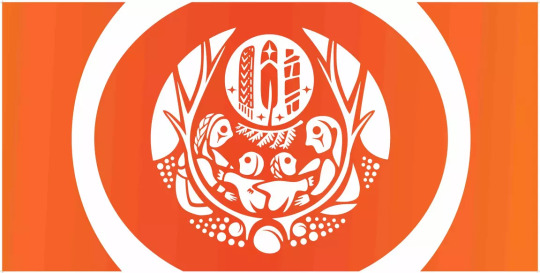



Survivors experienced horrific atrocities while prisoners in these institutions. It is important that this image show the love and strength that colonialism tried to steal from us. Despite genocide, we are still here – still fighting for justice and restitution, as true Warriors. - Dorene Bernard, Mi’kmaq Survivor who attended Shubenacadie Residential School
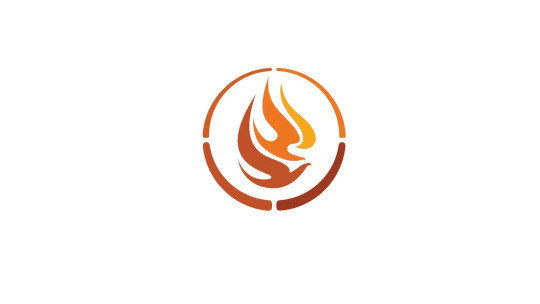
#chromatic voice#national day for truth and reconciliation#first nations#inuit#metis#missing and murdered indigenous women#mmiwcanada#residential schools#indigenous#turtle island#unceded land#survivor testimony#orange shirt day
317 notes
·
View notes
Text
The NDP is calling on Liberals to support searches of residential school sites.
In a press release from the party, Deputy Critic for Indigenous Services, Niki Ashton, says communities, such as Pimicikamak Cree Nation, which are trying to conduct their own searches need federal funding.
“The funding intended to support this critical work is set to end by 2025. We call on the Liberals to renew this essential funding in the next federal budget,” said Ashton.
The NDP says First Nations leaders and the International Commission on Missing Persons have pledged support for the initiative.
The party says the “lack of support” by the Liberal government for Pimicikamak Cree Nation is slowing down searches at sites in the region, something it’s been “ready to move forward with” for multiple years. [...]
Continue Reading.
Tagging: @politicsofcanada
#cdnpoli#Manitoba#Winnipeg#residential schools#Indigenous persecution#genocide#cultural genocide#child death#NDP#Pimicikamak Cree
128 notes
·
View notes
Text
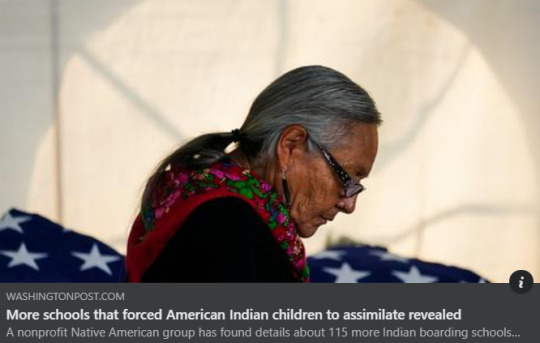
https://www.washingtonpost.com/nation/2023/08/30/indian-boarding-schools/
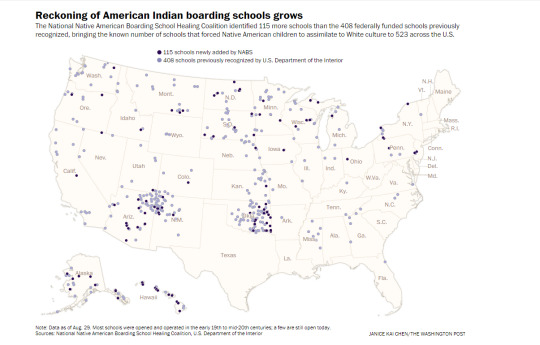
For those who can't read the small texts, every purple dot you see on this map of the United States is a residential school that the U.S. Department of the Interior recognized. There are 408 of them.
The black dots are 115 MORE schools that the National Native American Boarding School Healing Coalition recognizes with their new criteria.
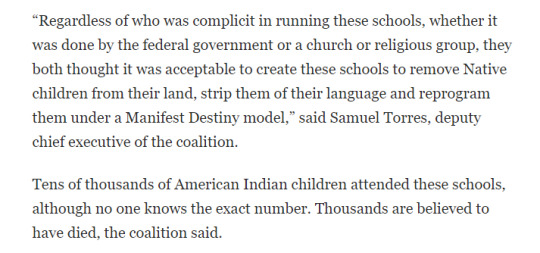
#residential schools#anti native racism#anti-native racism#native american#indigenous#ndn#cultural genocide
304 notes
·
View notes
Text
Just remember this when you celebrate Canada Day...if you are.
215 and counting.
I have no idea what the number is now.
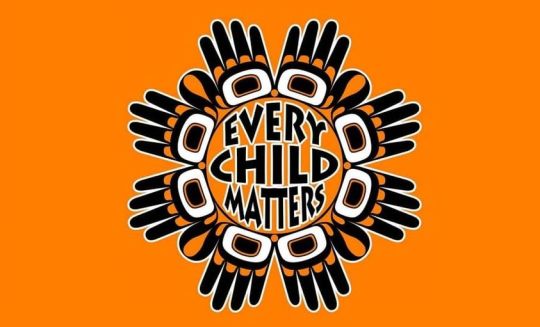
#canada day#i will not be celebrating#canadian history#this is our history#never forget#residential schools#indigenous people#tiktok#every child matters
325 notes
·
View notes
Text
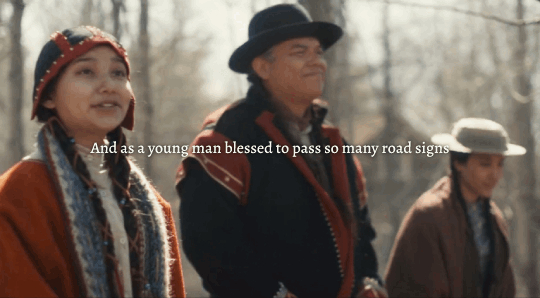

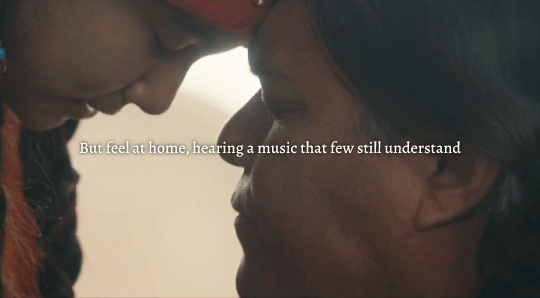
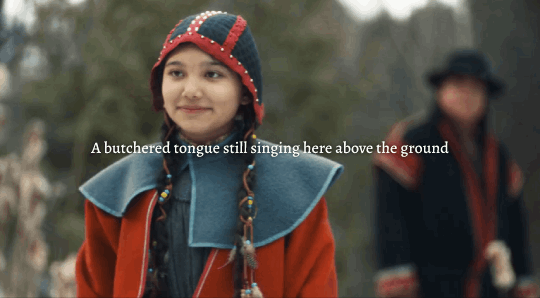


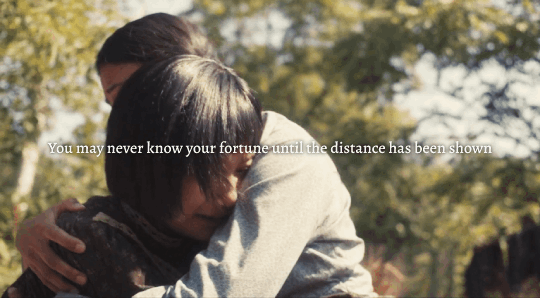

So, this song I’m about to sing you, it fits appropriately enough on the circle of violence in this album, and it just, it’s like a poem set to music that I suppose tries to credit the experience of going to different parts of the world that have indigenous names, so Apalachicola, Hushpuckena, places in Australia that we would visit, and then I would ask locals, “What does this place name mean?” and no one being able to tell me what it meant. And it just, I suppose, credits that experience. And recognizing as an Irish person, that although there’s many place names, there’s a great written history in Ireland, and we’re very fortunate that we can still learn much of the language and it’s very accessible to us, the place names and their meaning is very accessible to us, and that is not always the case everywhere you go in the world. (x)
#ka'kwet#kiawentiio tarbell#anne with an e#hozier#andrew hozier byrne#butchered tongue#unreal unearth#residential schools#cultural genocide#indigenous languages#forced assimilation
204 notes
·
View notes
Text
It really irks me when people only refer to the residential schools that are listed from the 2006 settlement. It's a straight up factual error to say there were only 140. There were well over a thousand, but the government won't apologize or compensate for those ones with the excuse being that they weren't federally supported, instead exclusively run by the church.
Also, day schools are forever excluded, despite being just as abhorrent. That's thousands more.
Also also, did you know that the five residential schools in NFLD were not included in the settlement through the loophole that the schools were established prior to joining confederation? Despite the last one not closing until 1980?
102 notes
·
View notes
Text
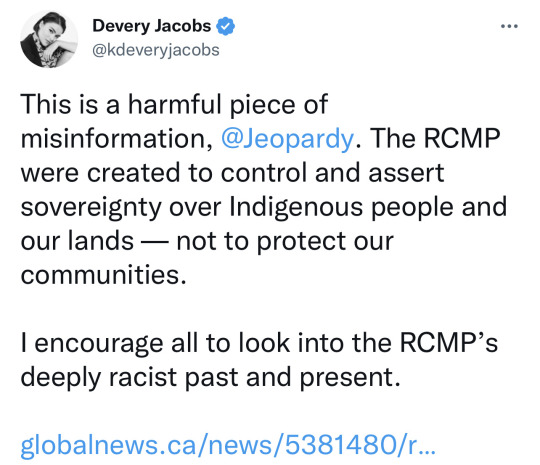

Whitewashing History 101: The police “cleaned up” those “sleazy” whiskey traders :)
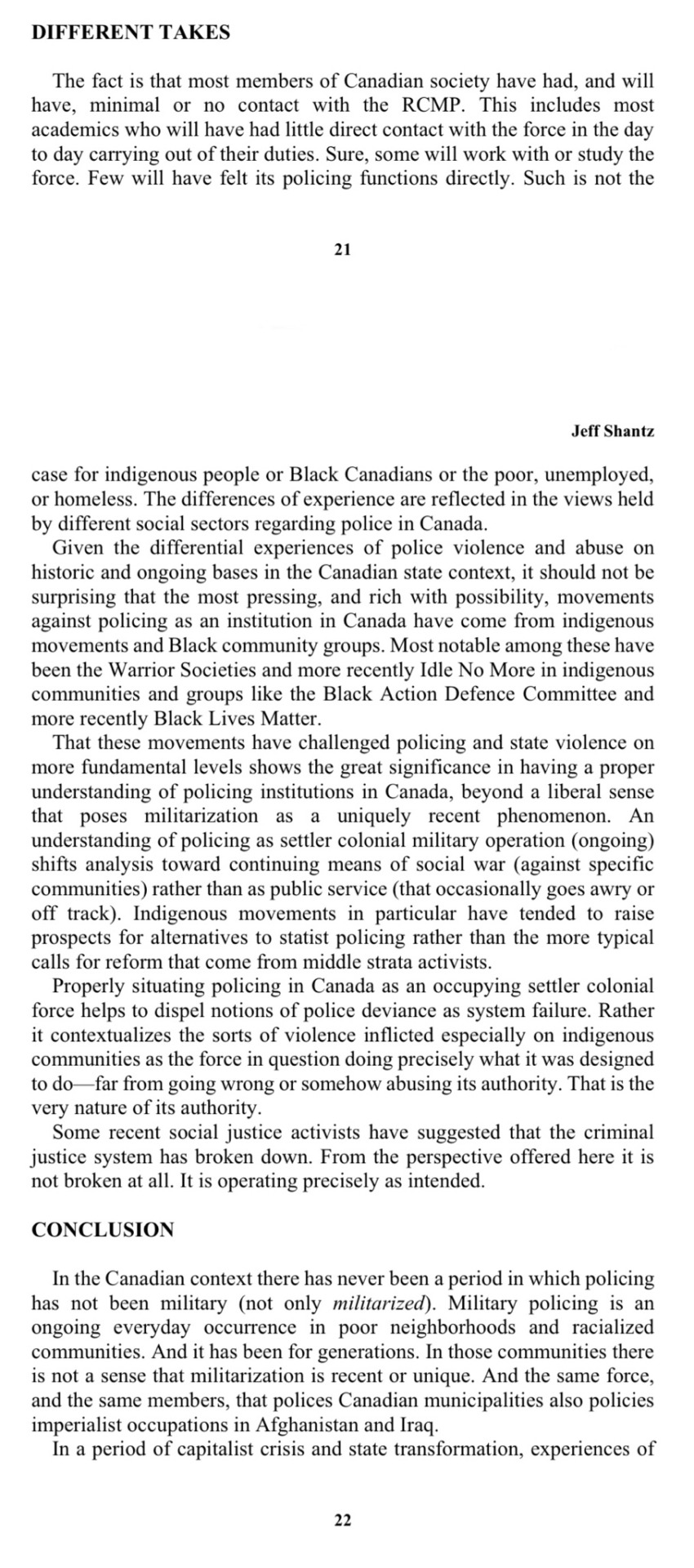
The RCMP Was Created To Control Indigenous People
Although the North-West Mounted Police didn’t become the RCMP proper until it absorbed the Dominion Police in 1920, its paramilitary origins are still highly visible in everything from its training depot to how it organizes its officers into troops, right down to the horse and the uniform, Hewitt says.
And while Canadians may like to position ourselves in opposition to the United States, citing their “even worse record in terms of treatment of Indigenous people,” Hewitt says that’s just a myth we tell ourselves to feel better.
The job of the Mounties “effectively, was to clear the plains, the Prairies, of Indigenous people,” he says. “Ultimately, they were there to displace Indigenous people, to move them onto reserves whether they were willing to go or not.”
History books, commissions, inquiries and public apologies reveal what happened next: Indigenous people who resisted were starved onto reserves. The federal government brought in the Indian Act and used Mounties to forcibly remove Indigenous children from their homes, placing them in residential schools rife with abuse.
(continue reading)
#politics#jeopardy#rcmp#canada#whitewashing history#settler colonialism#revisionist history#police#erasure#white supremacy#imperialism#residential schools
564 notes
·
View notes
Text

In honour of the lost lives and innocence taken too soon.
#cnanada#united states#indigenous#first nations#orange shirt day#truth and reconciliation#national day of truth and reconciliation#justice#residential schools
127 notes
·
View notes
Text
“Zitkala-Ša’s accounts of her boarding school days are full of sensory detail bringing to life the trauma of her ordeal—an effective technique for enabling her readers to imagine that they, too, can feel the iron routine penetrating their flesh. She keenly apprehended both the scientific and military goals of Indian education. It is “heart rending,” she later wrote to her lover, the Apache physician Carlos Montezuma, “to see a government try experiments upon a real race” that rendered boarding school children “practically prisoners of war.”
-Kyla Schuller, The Trouble with White Women
25 notes
·
View notes
Text
I have learned that in order to teach this play here, where many student readers are Indigenous, I must maintain a keen awareness of the intergenerational trauma inflicted by the Canadian Indian Residential School program. The fact that Prospero abusively educates Caliban while insisting that he is treating him with “humane care” (1.2.415) in the play reminded us of the ways that some educators at Indian Residential Schools could be physically, sexually, and spiritually abusive while, at the same time, claiming that they were doing God’s work. How many of our parents, grandparents, and extended family members were treated like Caliban by people who, like Prospero, felt entitled to do so?
#Manitoba#winnipeg#canada#teaching#education#the tempest#tempest#shakespeare#william shakespeare#residential schools#indigenous
33 notes
·
View notes
Text
Content Warning for discussions of residential schools and the systemic violence and abuse of Indigenous children.
It was a reunion decades in the making and a kickoff to the new year the Quill family will never forget.
Sisters Nita and Brandy Quill met for the first time at a SkyTrain station in Vancouver last week, more than 30 years after they were separated during a period of colonial violence against Indigenous families known as the ’60s Scoop. The pair found each other on Facebook in the years after their mother’s death.
“It’s surreal. Nothing like this has ever happened in our lives before,” Brandy said, embracing her long-lost sister at Burrard Station downtown.
“This is to me a miracle. I’m just trying to take it in. It will probably take a long time to process it. It’s a dream come true.”
Continue Reading
Tagging @politicsofcanada
#cdnpoli#canada#canadian politics#canadian news#indigenous#first nations#child abuse#indigenous child welfare#sixties scoop#residential schools#anti indigenous violence#genocide#cultural genocide
222 notes
·
View notes
Text
At 5 years old, Mark Maryboy left his home on the Navajo Nation Reservation to attend a boarding school about 150 miles away.
He would attend a total of three boarding schools over the next few years. He described the dormitory in which he lived as ripe with sexual and physical abuse, harassment and bullying — something his principle did nothing to stop after Maryboy alerted him to what was happening. At one school, Maryboy remembers seeing another student drown after an instructional aide told students to cross a river, despite the fact that some students did not know how to swim."
It was the damnedest thing I ever did in my life," Maryboy said, adding that he often wonders how his life would have turned out without that trauma. "Going through that experience has a huge impact on you. It's a lifetime sickness that goes into your mind."
...
For Norman Cuthair Lopez — who has held a variety of positions in the Ute Mountain Ute Tribe — going to the Ute Vocational School was a shock, in more ways than one. Despite already speaking two languages, his native Ute and Navajo, he struggled to learn English. Upon arriving at the school, his long hair was cut, and then he was stripped and scrubbed clean.
The first night was particularly difficult. At home, he hadn't slept on a bed, so he laid down underneath his bed on the first night at school. It proved to be a costly mistake.
"I got the spanking of my life," he said. It was a new experience, since his grandparents had always used their voices rather than their hands to discipline him at home. "I had the shock of my life when I got my first spanking. The guy that was there, one of the supervisors, picked me up and threw me against the wall."
....
Willie Grayeyes, Navajo Nation member and San Juan County commissioner, went to multiple boarding schools across the Southwest. Most of the time, he had no idea where he was being sent.
One night, in fourth grade, Grayeyes was told to sleep in clothes, not pajamas. He and other kids were woken during the night and loaded into trucks. By morning, they reached Richfield. He said the dormitory there was nothing more than a warehouse with a partition in the middle to separate boys and girls.
"I had no idea where I was going. Nobody said this is why we're sending you here," he said. "The decision was made 100 miles away, not at my home but at the Bureau of Indian Affairs building."
He would have a similar experience a few years later after returning home for a family illness. The Bureau of Indian Affairs superintendent sent him to Flagstaff, Arizona. From there he took two Greyhound buses, to Albuquerque and then Santa Fe. Later, he would also attend the Phoenix Indian School. Being separated from his family all that time impacted him and how he viewed his identity is something he said has impacted him his entire life.
#Utah#native americans#alaska natives#Boarding schools#Residential schools#ICWA#indian child welfare act#Navajo#Ute
144 notes
·
View notes
Text
"I’ve lost my long hair; my eagle plumes too. / From you my own people, I’ve gone astray. / A wanderer now, with no where to stay."
Read it here | Reblog for a larger sample size!
#open polls#polls#poetry#poems#poetry polls#poets and writing#tumblr poetry#have you read this#the indian's awakening#zitkála-šá#gertrude simmons bonnin#native american#sioux#residential schools
8 notes
·
View notes